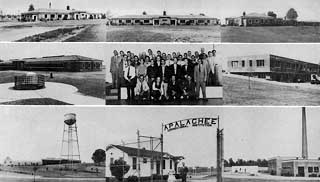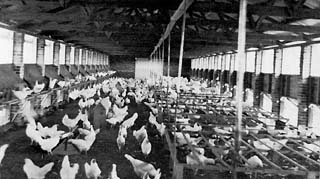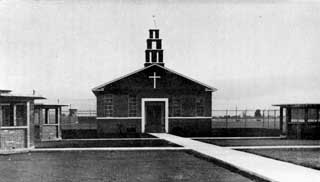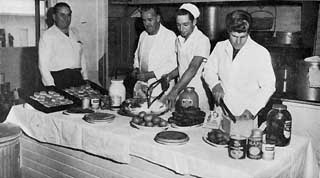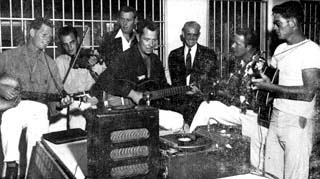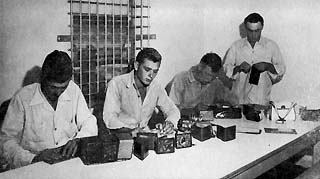1953
INMATE POPULATION DECEMBER 31, 1953: 3,877
Correctional Officer Grant Dohner is killed during an escape attempt at Loxahatchee Road Prison on January 15, 1953. Officer John F. Gradon was injured during the same incident. The Loxahatchee Road Prison chapel was later dedicated to Officer Dohner.
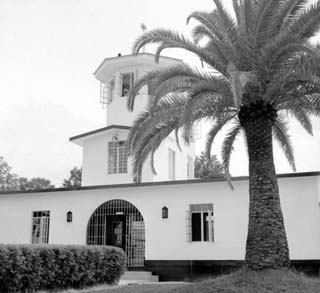
Main entrance of Florida State Prison at Raiford (1954). (Photo courtesy of FPC.)
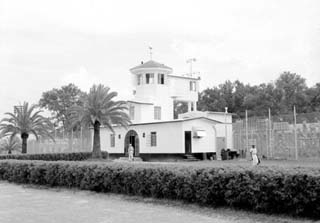
Main entrance of Florida State Prison at Raiford.
1954
INMATE POPULATION DECEMBER 31, 1954: 4,340
The Thirty-third Biennial Report of the Prison Division of the Department of Agriculture of the State of Florida for the Years 1953 and 1954 provides the following photos and information:
1953-1954 REPORT
At the close of year 1954 our prisoners were housed as follows:
In order that you may have first hand information as to activities, I am quoting comments; also pictures from four of the larger divisions. Florida State Prison, Raiford, Florida Four facts with reference to the prison system are evident. First, the steady increase in prison population. Second, the steady increase of white prisoners and the decrease of Negro prisoners. Third, the vast percentage of prisoners who have come from out of the state. Fourth, the prospect of the building of the new Women's Prison near Ocala. While the removal of the women from the State Prison offers some relief of the crowded condition at the present, the steady and rapid increase of men in the prison population indicates that new facilities must be provided in the near future. More than two hundred prisoners are now housed in tin buildings of the quonset type and some of them sleep in tiers three deep. Good sanitary conditions are impossible in such circumstances and security is likewise impossible. Unless the law is changed to provide for the sending of narcotic patients to other institutions, a separate hospital building will be required to house these unfortunate and tragic people committed by the Courts for an indefinite period. It appears that more and more of the Courts are using this method for handling narcotic addicts and it is impossible to provide hospital space for them under present conditions. It is hoped that the Legislature will provide other means for treating these patients. As the State grows we must expect a steady increase in the size of the prison population and more and more to career criminals who come to Florida in the winter time following the crowds. Many such prisoners require strict discipline and careful supervision. As the State grows prison problems grow with it. Apalachee Correctional Institution The program designed at this institution offers training opportunities in character building experiences for youthful offenders; a program for developing vocational skills; an institution in which the youthful offender may experience another type of parental guidance. It has been found that a great many of the young men committed to our Prison System are in trouble resulting from inadequate home or family life, physical and mental handicaps, incomplete schooling, lack of vocational training, and poor economic or social standards. Statistics prove that 98 out of every 100 men who enter prison leave as free men. Only 2% of those persons committed stay in Penal Institutions for the remainder of their lives. If we are to aid in the rehabilitation of a larger number of this 98%, we must increase our facilities. Our present facilities were designed for a population of 150 inmates -- the present population exceeds 200.
Since our last biennial report, we have assumed operation of the brick plant, which is now producing about 250,000 bricks per month. The bricks are used for additions to our plant, and by other State Institutions and Agencies.
Our poultry farm, while only in operation less than one year, is now producing about 6,000 fryers and 1,400 dozen eggs per month. Surplus over our own consumption is supplied to Florida State Hospital. To meet the demands of the two institutions, production will have to be increased to about 12,000 fryers and 18,000 dozen eggs per month. Inmate labor is used in the operation of the brick plant and poultry farm. No free labor used other than supervision by members of our staff. Glades State Prison Farm At Belle Glade we have approximately 2,000 acres of land used for crop cultivation and pasture. Four hundred acres of this land is used to raise sugar cane from which we manufacture in our cane mill right on the farm, sugar, syrup and molasses. The molasses is used in cattle feed. The sugar and syrup are used at our institution and shipped to other state institutions and road camps for use in feeding inmates. We also operate a canning plant and each year can approximately 300,000 cans of green beans and tomatoes, which are grown on the farm. We also grow and process 3000,000 pounds of dried beans each year, such as Great Norther, Pinto, Red Kidney and Navy. This canned food and dried beans are also used by this institution and shipped to other state institutions and road camps. We have about 2,000 head of cattle located at Belle Glade, Clewiston and Arcadia. All bulls are pure bred. We have some pure bred cows at Belle Glade and the bulls are Angus and Short Horns. At Clewiston the bulls are pure bred Angus and at Arcadia, pure bred Brahman.
There is a population of approximately 278 inmates at this institution. We have a very nice chapel located inside the grounds where two services are held each Sunday, consisting of morning services for the white and afternoon services for the colored. Once a week there is a movie. Inmates have a very active Alcoholics Anonymous Group which meets each Saturday afternoon. State Road Department, Prison System The State Road Department has thirty-six prison camps that are located at various points throughout the State. The camps have an average population of forty-five prisoners each. The prisoners from these camps, with the exception of those used in the maintenance of the camp proper, are engaged in maintenance work on most of the State Roads in the State Highway System. Each camp is geared to maintain the roads within a thirty to forty mile radius of the camp. The men work approximately ten hours a day, five days a week. From the prisoners standpoint it is much more desirable to work in the open Florida sunshine than to be locked in cells behind walls and of course is much healthier.
For the past two years we have had in our employ a steward who was formerly with the Federal Correctional System, who prepares menus, instructs inmate cooks in food preparation, serving, sanitation, etc. This has resulted in vast improvement in our culinary departments, so much so, that complaints about food are a thing of the past. A local physician (on call basis) is employed at each camp to take care of the physical well being of the inmates.
|
- 1821-1845
- 1868-1876
- 1877-1895
- 1900-1919
- 1921
- 1922-1924
- 1927
- 1928-1931
- 1932 | CHAPMAN
- 1933-1935
- 1936-1939
- 1940-1945
- 1946-1949
- 1950-1955
- 1956-1961
- 1962 | WAINWRIGHT
- 1963-1965
- 1966-1969
- 1970-1975
- 1976-1979
- 1980-1986
- 1987 | DUGGER
- 1988-1990
- 1991 | SINGLETARY
- 1992-1995
- 1996-1998
- 1999 | MOORE
- 2000-2002
- 2003 | CROSBY
- 2004-2005
- 2006 | MCDONOUGH
- 2007
- 2008 | MCNEIL
- 2009-2010
- 2011 | BUSS
- 2011 | TUCKER
- 2012 | CREWS
- 2013-2014
- 2014 | JONES
- 2015-2018
- 2019 | INCH
- 2020-2021
- 2021 | DIXON
- 2022-Today
- Population Summary Table

